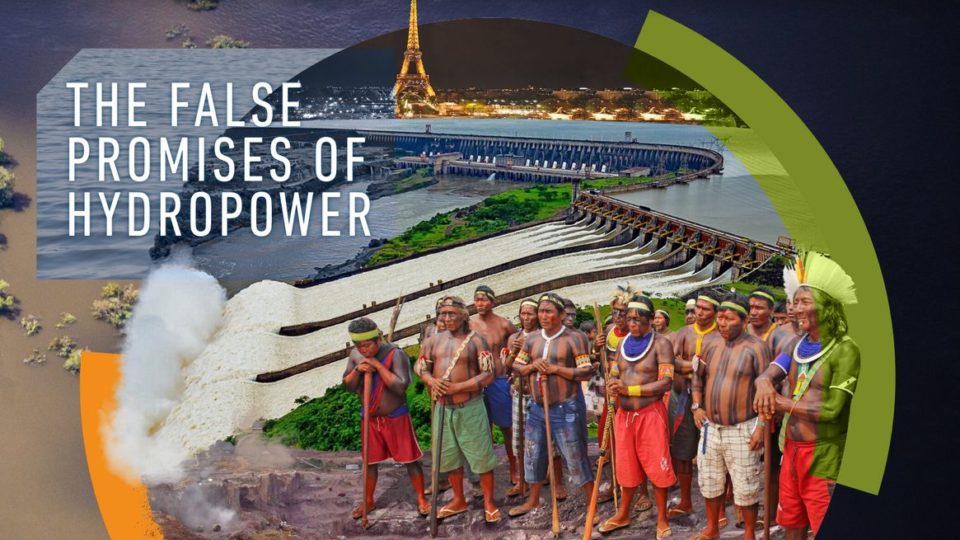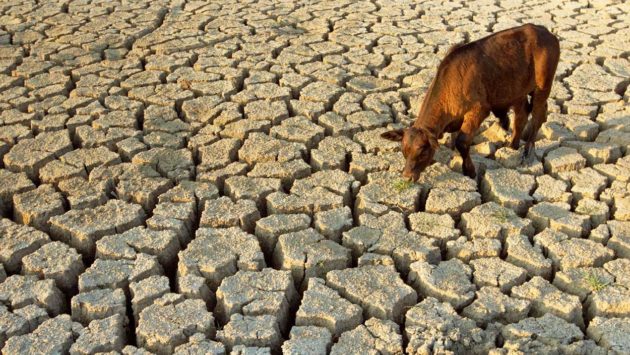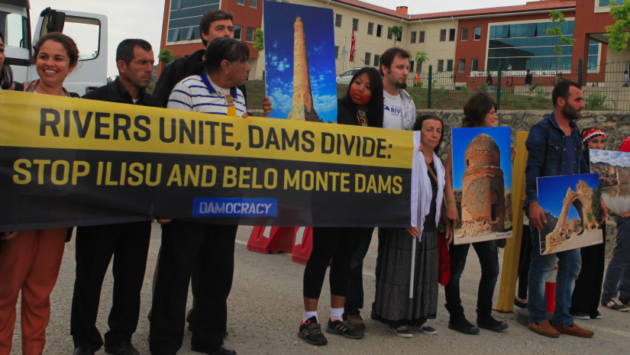The False Promises of Hydropower: How dams fail to deliver the Paris Climate Agreement and the UN Sustainable Development Goals
The False Promises of Hydropower:
How dams fail to deliver the Paris Climate Agreement and the UN Sustainable Development Goals
A Joint Statement by Civil Society Organizations on occasion of the 2019 World Hydropower Congress in Paris, France
Paris, May 13th, 2019
We live in an age of urgency. Scientists have warned that we have little time to act to bring climate change under control and protect the integrity of life on our planet. Confronting the climate crisis requires creative solutions that both protect nature and respect human rights. Facing these challenges, we cannot remain silent onlookers while corporate profiteers, financiers, and their allies peddle false solutions for addressing climate change and implementing sustainable development.
A flagrant example of such deception is the attempt to portray large hydroelectric dams as a ‘clean and green’ source of energy, as can be seen at the 2019 World Hydropower Congress. Organized in Paris by the industrial lobby of the International Hydropower Association (IHA) in partnership with UNESCO, the conference’s title reads, “Delivering the Paris Climate Agreement and the Sustainable Development Goals.”
Such glossy portrayals of hydroelectric dam projects—with an eye toward capturing financial incentives through mechanisms like Climate Bonds and the Green Climate Fund—conveniently ignore a long legacy of social and environmental catastrophes, economic waste and, all too often, massive corruption schemes that are the antithesis of truly sustainable development.
Let’s consider some of the facts:
- Large hydropower projects – as well as cascades of smaller dams – have often provoked devastating impacts on highly vulnerable communities, including indigenous peoples. Hydroelectric dams, together with reservoirs and transmission lines, have forced the displacement of an estimated 40 to 80 million people without just compensation or reparations. The social and environmental consequences of hydropower projects extend far beyond these immediate impacts. With giant walls of concrete, hydroelectric dams cause profound impacts on freshwater ecosystems, disrupting the natural flow of water and sediments, impeding movements of migratory fish, deteriorating water quality, eliminating unique habitats and undermining biodiversity—all of which adversely impact the rights of local populations that depend on healthy, free-flowing rivers. It was recently estimated that hydroprojects have compromised the livelihoods of up to 472 million people living downstream from dams.
- Dam construction, especially in frontier areas like the Amazon, Tibetian Plateau, Congo and Siberia, has typically been accompanied by the opening of penetration roads, massive immigration, an escalation in illegal land-grabbing, logging, deforestation, and mining—all associated with increased levels of violence. The recent murders of human rights and environmental defenders like Berta Caceres in Honduras and Dilma Ferreira Silva in Brazil illustrate that extreme violence in rural areas is often directly traceable to dam proponents or linked to socio-environmental conflicts triggered by hydroprojects. Dramatic increases in urban violence and declining social indicators have also become commonplace in municipalities like Altamira, Brazil, heavily impacted by the Belo Monte mega-dam.
- Particularly in tropical regions, hydropower reservoirs emit significant amounts of greenhouse gases, being one of leading sources of human-induced methane emissions, which is much more powerful than carbon dioxide in provoking global warming. In some cases, hydropower projects are producing higher emissions than coal-fired power plants generating the same amount of electricity.
- Dams destroy forests, which serve as one of our planet’s greatest carbon sinks and contribute to the fight against climate change. Recent studies have shown that, due to the effects they have on the hydrological regime, dams also harm trees and other vegetation, even those far away from the dam site itself. In frontier regions, dams open the door to extractive industries like mining, logging and agriculture, further threatening forests.
- Large hydropower projects often destroy cultural and historical heritage sites. Two recent examples include the flooding of the 10,000-year old historical town of Hasankeyf by the Ilisu Dam on Turkey’s Tigris River and the destruction of the ‘Sete Quedas’ waterfalls on the Teles Pires River in the Brazilian Amazon—a sacred place of great spiritual importance for the Munduruku, Apiaka and Kayabi indigenous peoples.
- In numerous cases, large hydroprojects are threatening or already affecting UNESCO World Heritage sites, as in the case of the Gibe III dam in Ethiopia, which is producing disruptive downstream impacts on the Omo River and Lake Turkana in Kenya. The assault on these global natural treasures is illustrated by the fact that at least 20% of natural World Heritage sites are affected or threatened by dams or other water infrastructure projects; this percentage has increased over the last 5 years.
To make matters worse, mega-dams, with their chronic cost overruns and construction delays, have frequently left countries buried in public debt, as in the case of the Coca Codo Sinclair hydroproject in Ecuador, impairing the abillity of governments to invest in transitions to truly renewable energy estrategies.
Meanwhile, technological innovations in solar and wind generation are increasingly undermining the competitiveness of hydropower as an affordable energy source. In fact, hydropower has become the most unreliable of all non-fossil energy options, especially within the context of global climate change, with worldwide annual installations dropping by 50% over the past five years.
Given such fundamental problems, what has allowed for the propagation of destructive hydroelectric projects around the globe? And why have their advocates often benefitted from economic incentives, including carbon credits and ‘clean energy’ finance?
- The prioritization of large dam projects within national energy policies typically occurs in centralized decision-making processes. Such processes are characterized by an absence of transparency, citizen participation, and methods of strategic planning that would promote a comprehensive evaluation of energy needs that considers the social, environmental and economic costs and benefits.
- Political decisions concerning the identification of ‘optimal sites’ for dam construction are often based on basin-level inventory studies commissioned by private and state-owned construction companies, in which energy generation potential is essentially the sole criterion, while social and environmental impacts are downplayed or simply ignored. In some cases, basin-wide studies are not conducted at all.
- At the project level, environmental impact assessments are typically conducted and/or financed by dam proponents that systematically underestimate social and environmental impacts while grossly overestimating socio-economic benefits, based on an overriding concern with maximizing profit margins and demonstrating project “viability.”
- Proponents often downplay the extreme vulnerability of hydroelectric projects to a changing climate; the periods of extreme drought and flooding predicted by climatologists, and increasingly apparent in many areas of the world, tend to render many dams useless during much of the year.
- There has also been a tendency to ignore the considerable body of scientific literature demonstrating that dams, particularly those located in the tropics, cause significant greenhouse gases emissions. These dams produce their peak emissions in the years after a reservoir is first filled, vastly hindering our efforts to limit the global temperature increase to 1.5 degree Celsius above preindustrial levels, as accorded in the Paris Agreement.
- A recurring characteristic of hydroelectric dam projects has been the absence of processes for free, prior and informed consultation and consent among indigenous peoples and other traditional communities, as guaranteed by ILO Convention 169 and the UN Declaration on the Rights of Indigenous Peoples (UNDRIP). The lack of such provisions within the IHA’s Hydropower Sustainability Assessment Protocol (HSAP) and other “sustainability tools” is a glaring omission.
- Among corporate actors and financial institutions engaging in hydroprojects at a relatively advanced stage, a chronic problem has been a lack of adequate due diligence in managing social and environmental risks, including vetting projects for records of human rights violations like the absence of free, prior and informed consent among affected communities.
- There has been an absence of robust, independent monitoring of socio-environmental impacts and the effectiveness of legally required mitigation and compensation measures as a basis for improved governance, including as benchmarks for loan disbursements by financial institutions.
- When the dam industry has encountered difficulties in securing environmental licenses for poorly planned high-risk projects, members have frequently used their privileged access to high-level government officials to exercise leverage over key decision makers. Another frequent tactic has involved political interventions within judicial systems to undermine lawsuits that question violations of human rights and environmental legislation. Cooptation, intimidation and criminalization of movements, together with use of armed forces, have been adopted to undermine social mobilization and protests of dam-affected peoples in defense of their rights.
- Massive corruption scandals involving the hydropower industry indicate its central role as a driver of unethical, repressive and illegal behavior to sustain destructive dam projects. Three recent examples include revelations of nepotism, shady property deals and dodgy bidding procedures within the China Three Gorges Corporation, Brazil’s Lava Jato investigations – which revealed extensive bribery by companies like Eletrobras and Odebrecht in dam-building contracts – and the Kirchner and Cerpernic mega-dams in Argentina, authorized as the direct result of under-the-table payments from dam companies to public officials, while impacts on the Perito Moreno glacier, a UNESCO World Heritage site, were simply ignored.
- The hydropower industry, led by the IHA, has resisted the adoption of robust social and environmental standards, such as the rights-based approach of the World Commission on Dams. They have opted instead for the application of voluntary, self-defined ‘best practices’ among a selected number of projects. Notwithstanding other limitations, the IHA’s Hydropower Sustainability Assessment Protocol has been applied and made public for less than 1% of hydroelectric dam projects planned and built within the last ten years.
While illusions of “sustainable hydropower” have been propagated to global audiences through sophisticated communications strategies, key members of the industry have continued to dam many of the world’s most biologically diverse and socially important rivers, including the Mekong, Xingu, Madeira, Teles Pires, Yangtze-Jinshajiang, and Bureya.
Meanwhile, there are active plans to dam many of the world’s last remaining free-flowing rivers: the Congo, Lena, Irrawaddy, Vjosa, Nu-Salween, Amur-Heilongjiang, Selenga, Marañon, Juruena, Tapajós, Beni, Shilka and Karnali rivers, among others. Enough is enough!
A Call for Action
The undersigned civil society organizations call on the members of the International Hydropower Association, governments and international financial institutions to implement the following urgent actions:
- Steer priorities, investments and financial incentives away from additional hydroelectric projects and towards energy efficiency and truly sustainable renewable energy options (solar, wind and biomass and, when appropriate, micro-hydro). Special attention should be given to opportunities for technological innovation, decentralized generation and improving energy access among isolated, off-grid communities.
- Eliminate financial incentives for new hydroelectric projects within climate change mechanisms, such as the Green Climate Fund and Nationally Determined Contributions, and within programs to promote implementation of the UN Sustainable Development Goals (with the possible exception of micro-hydro projects).
- Commission independent audits of controversial existing dam projects and basin-wide cascades in terms of their social and environmental consequences, identifying steps to mitigate impacts and ensure just reparations for affected communities, based on direct consultations. When such measures are prohibitively expensive or otherwise inviable, the de-commissioning of dam projects should be undertaken.
- Ensure the alignment of operational procedures for existing hydroprojects with relevant territorial plans at the basin level, such as integrated water resource management and protected areas that ensure key ecological processes and the rights of local communities, based on the concepts and tools of participatory, adaptive management.
- Ensure that renewable energy policies and projects adopt, across the board, robust guidelines to safeguard human rights and environmental protections, such as ILO Convention 169 and the UN Principles on Business and Human Rights. No energy facilities that potentially impact the territories and livelihoods of indigenous peoples and other traditional communities should be authorized without obtaining the free, prior and informed consent of the community and ensuring the cooperative design of co-management strategies.
Among the benefits of such a paradigm shift in energy strategies and development planning will be major contributions toward protecting the world’s last free-flowing rivers, vital for climate resiliency, biodiversity conservation and sustainable livelihoods.
Energy companies and governments must halt all efforts to dam the world’s remaining free-flowing rivers and concentrate instead on: i) improving efficiency and the sustainability of existing hydropower projects and cascades; and ii) investing in energy efficiency and truly sustainable renewables.
Moreover, governments must urgently promote the permanent legal protection of the world’s last free-flowing rivers, including transboundary watercourses, with due respect for the territorial rights of indigenous peoples and other traditional communities, who play fundamental roles as the guardians of healthy rivers.
Signed by Save the Tigris Campaign and +250 other civil society organisations




